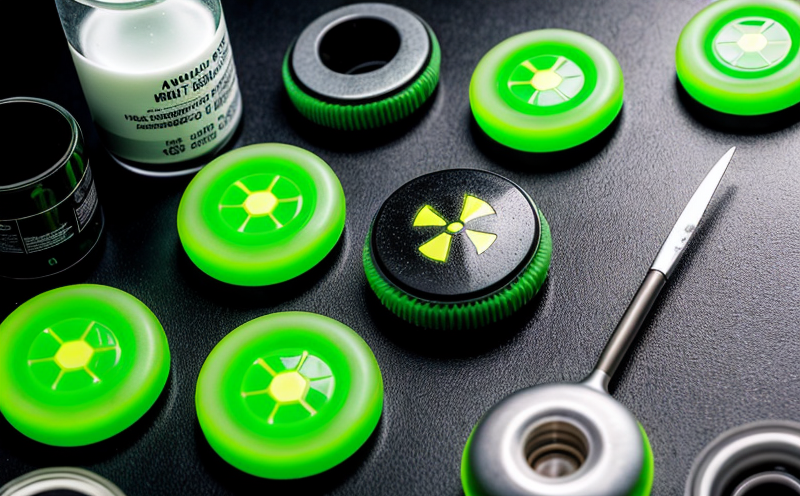AOAC 2001.05 Radioactive Isotope Testing in Animal-Origin Foods
The AOAC International method 2001.05 is a critical analytical tool used to quantify radioactive isotopes, particularly 137Cs and 90Sr, in animal-origin foods such as meat, dairy products, and pet food. This procedure is essential for ensuring the safety of these products by detecting and quantifying potentially harmful levels of radioactivity which may have originated from nuclear fallout or other sources.
The AOAC 2001.05 method involves several key steps: sample preparation, radionuclide extraction, purification, and measurement using a low-background gamma spectrometer. The method is designed to be sensitive enough to detect minute quantities of these isotopes that might otherwise go undetected by less sophisticated techniques.
The primary application of this test lies in the verification of compliance with international food safety standards such as ISO 17025 and the European Union's Official Control Regulation (EC) No 852/2004. It ensures that food products are safe for human consumption, thereby protecting public health.
For accurate results, it is important to follow strict procedural guidelines. Sample preparation involves thorough cleaning of the sample matrix using appropriate solvents and filtration methods to prevent any contamination or loss during extraction. The extracted radionuclides must then be purified further before being analyzed by gamma spectrometry. This step ensures that only the desired isotopes are detected, minimizing interference from other naturally occurring elements.
The detection limit for this method is typically around 0.1 Bq/kg, which allows for precise quantification even at very low concentrations. The precision of the results can vary depending on several factors including sample matrix effects and background radiation levels. To achieve optimal accuracy, it's crucial to conduct multiple replicate analyses and apply correction factors where necessary.
The use of this method is particularly relevant in regions affected by historical nuclear testing or those prone to radiological contamination events. By regularly monitoring food products for radioactive contaminants, regulatory agencies can take swift action if any exceedance limits are detected. This not only helps maintain consumer confidence but also demonstrates the commitment to maintaining high standards of public health.
In summary, AOAC 2001.05 plays a vital role in safeguarding our food supply chain by providing reliable data on radioactive isotopes present in animal-origin foods. Its rigorous protocols and stringent quality assurance measures ensure that consumers receive safe products free from harmful levels of radioactivity.
Benefits
The implementation of AOAC 2001.05 offers numerous benefits to various stakeholders within the food industry:
- Enhanced Safety: Ensures that all processed foods meet strict safety standards, protecting public health.
- Compliance Assurance: Helps manufacturers comply with international regulations and guidelines regarding radioactivity in food.
- Reputation Building: Demonstrates a commitment to quality control and ethical business practices, enhancing brand reputation.
- Cost Efficiency: Early detection of contamination issues can save significant costs associated with recalls or reprocessing.
Beyond these direct advantages, adopting this method also contributes positively towards sustainable development goals by promoting responsible resource use and environmental stewardship.
Customer Impact and Satisfaction
The adoption of AOAC 2001.05 has a profound impact on both customers and suppliers in the food sector:
- Increased Trust: Consumers trust brands that adhere to rigorous testing protocols, leading to increased customer loyalty.
- Improved Quality Perception: Suppliers who implement this method gain recognition for their commitment to producing high-quality, safe products.
- Competitive Edge: Companies demonstrating superior food safety practices are more likely to attract new business opportunities and partnerships.
- Sustained Growth: By maintaining consistent standards of quality and safety, businesses can expect steady growth in their market share over time.
A strong emphasis on food safety through robust testing methods like AOAC 2001.05 fosters long-term relationships with customers while contributing to overall industry stability and resilience against potential crises.
Use Cases and Application Examples
The application of AOAC 2001.05 extends beyond mere compliance; it offers practical solutions tailored to specific scenarios:
- New Product Development: Companies developing new formulations for animal-origin foods can use this method early in the process to identify any potential contamination risks.
- Batch Verification: During production, regular batch testing ensures that each shipment meets required safety standards before being released into the market.
- Supply Chain Monitoring: By implementing continuous monitoring throughout the supply chain, companies can detect and address issues promptly, ensuring consistent quality across all stages of processing.
- Post-Market Surveillance: After a product has entered circulation, periodic checks help maintain confidence among consumers regarding ongoing safety measures.
Incorporating AOAC 2001.05 into routine operations provides peace of mind for all parties involved in the food sector, reinforcing trust and fostering innovation.





